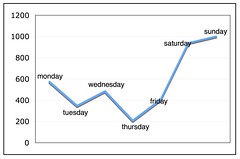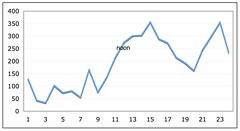The Pulse of a City
Posted: April 8th, 2007 | No Comments »I have been perfecting the system to collect and analyze the data for my “Tracing the Visitor’s Eye” experiment. I expect to cover data of a 2+ years period from 11 different cities (plus one region, and a small country). Today, I played around with a small set of 3365 photos and 22110 tags taken by 236 anonymous flickr users (avg of 14.26 photos/photographer) in Barcelona from January 15 until March 1 2007. I focused on the basic temporal aspect of the data to see if the pulse of the city could be extracted. Here are the yearly (2.5 months), weekly and daily patterns revealing “urban heartbeats”:

Yearly distribution over the period of January 15 and March 1. Bigger spikes appear between February 10 and February 15 for the 3GSM World Congress. Each weekend is a “urban heartbeat”. Would be interesting to compare how the attendees of 3GSM navigate the city as compared to other tourists.

Weekly distribution. As expected, the weekend triggers more activity

Daily distribution. Peaks in early afternoons and in the evenings. Similar to the graph of the GSM cell activity in the Milan metropolitan area
Of course, things will start to get interesting by crossing the temporal data with the accuracy, tags and spatial data to reveal the “where, what and why”. I am exploring techniques to categorize the photographers (tourists or citizen), create neighborhoods and areas of attractions of points of interests (probably by using the geonames dataset).
I am also observing very closely the experiments on the spatio-temporal data of Twitter (Mapping Twitter, twittervision, Twitter Maps – A Unique View of London) and Dopplr (Playing with sparklines on dopplr data). The very interesting aspect over these is that people not only disclose their history, but mainly the future intentions (Awareness of the future and some thoughts about classification). Studying how people disclose the location of their future intentions could help us understanding how to deliver in terms of location quality and timeliness such information.

